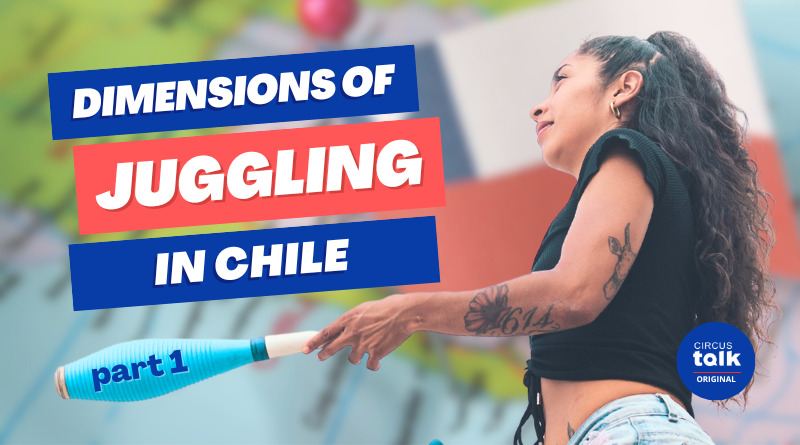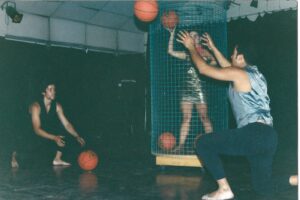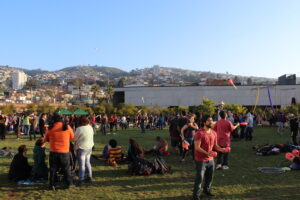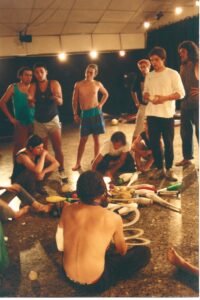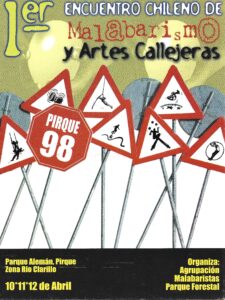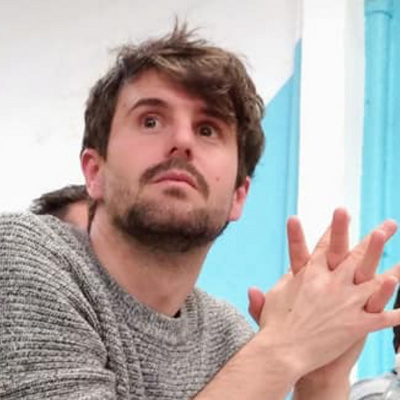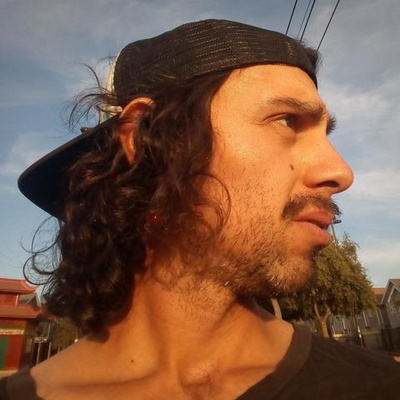Dimensions of Juggling in Chile – Docuseries Chapter 1: Introduction
When exploring a whole continent’s worth of circus cultures, it can be hard to keep track of the many unique people, stories, circus customs, and disciplines you encounter along the way… but the Está Pasando project is helping us get the lay of the land—starting with the fabulous Chilean juggling scene! All week long, we’ll be delivering to you a six-part documentary that takes viewers on a deep dive into a country’s diverse juggling culture. In this interview, Está Pasando’s Miguel Manzano and director Marcelo Troncoso let us know what to expect from the “Dimensions of Juggling in Chile” docuseries–as well as unveiling the first episode!
When CircusTalk gave me the opportunity to share the great adventure that “ESTÁ PASANDO” is, no one knew what would happen. It was a gamble. A leap into the unknown with a triple somersault. The good thing is that if you’re reading this, you’re accustomed to taking that kind of leap. So join me if you want to know a little more about circus in Latin America.
The first stop on our journey was Chile. I don’t know if you’re familiar with South America, but Chile is that strip of land between the Pacific Ocean and the Andes. Just as with the Himalayan mountain range, oceanic winds collide with these great mountains and create an enormous diversity of ecosystems at their feet. In the case of Chile, this diversity is such that in the northern part of the country, you have the Atacama Desert, home to the driest place on Earth, and in the southern part, you can find jungles,lakes with volcanoes, and even glaciers.
I like to think that cultural expressions are connected to the lands that nurture them. They are the way we, as human beings, flourish. So imagine the variety ofcultural flowers in such a diverse ecosystem like that of Chile. It’s no wonder that Maca Simonetti, one of the great promoters of circus in the country, wrote this magnificent article about its beautiful landscape.
For now, I have gathered over 30 circus stories, which I will be sharing with you, and I want to start with one that has always caught my attention. This is the story of the search for an answer to the question:why are there so many talented jugglers in Chile?
This search deserved more than just a few informal interviews. In fact, juggling in Chile is something so distinctive, so profound and ingrained, that we decided to be more ambitious: we would make a documentary.
For that, we got in touch withMarcelo Troncoso, a Chilean sociologist, researcher, and documentarian who has been studying the different expressions and realities of circus in his country for over ten years.
I could tell you myself how the adventure of making this documentary went, but I think it’s much more interesting to let Marcelo tell you himself.

Miguel Manzano (MM): Before delving into the documentary, could you tell me something about yourself, your research, previous audiovisual works, and what led you to explore the Chilean circus as the main theme of your work?
Marcelo Troncoso (MT):Ever since I was a child, I have had a close connection with the circus. In the neighborhood where I grew up, in the Maipú commune in Santiago, Chile, there was an empty plot of land just across the street next to an elementary school. Periodically, during winter vacations (July) or the national holidays (September), a circus would always be set up there, and during the summers (December-February), small amusement parks and fairgrounds with mechanical rides would be installed.
I remember that in the ’90s (I was born in 1987), the circuses that came there still had animal shows. It was the first time I saw lions, tigers, elephants, horses, donkeys, and monkeys. One thing that caught my attention was that they would set up the animal cages to form the perimeter of the circus, so anyone passing by could see the beasts in captivity in addition to the tent. As a publicity strategy, it was quite powerful on its own. Whenever I went to the circus back then it was to see the animals. Clowns or jugglers never seemed as impressive to me compared to wild animals. Even to this day, I associate the smell of animal excrement with the arrival of those circuses. Over time, by reading chronicles and history books and watching films and documentaries from different countries, I have realized that this “aromatic” element is very present in the codification of circus imagery from the 19th and 20th centuries. Nowadays, circuses no longer have that smell (as fortunately, that type of animal exploitation has been banned). That was my first encounter with the circus when I was a child.
A second moment that marked me a lot began around 1997 when I was in fifth grade. A classmate started bringing a variety of juggling toys (clubs, balls, rings, boxes, devil sticks, diabolo, etc.) to school with him. Thanks to seeing him juggle, I was able to learn how to do it, too, first with three balls, and then with three clubs. That was my initiation into juggling.
From then on, I always had a connection with juggling, whether by practicing it as a game with my friends from the neighborhood or as a spectator witnessing the proliferation of street juggling in the city of Santiago.
I would say that these two situations—the circuses that came to my neighborhood, and practicing juggling since I was a child—made the presence of the circus in my daily life feel very natural. It never seemed foreign to me. I would say that “the black box of the circus” was always open and visible to my eyes.
Then in around 2008, when I was studying sociology at the Universidad Alberto Hurtado, in Santiago de Chile, I started getting to know people who practiced aerial silks. Through them, I started training on fabric, then static trapeze. From then on and to this day, I have participated in many circus spaces, groups, and events. I have been constantly trying out different techniques such as Chinese pole, hand balancing, petite volant trapeze, and high rigging work, among others. That also allowed me to pragmatically engage with the circus as a phenomenon. All these accumulated experiences have led me to want to merge sociological research with performing arts.
Since then, I have become obsessed with analyzing and trying to understand the elements that define the circus as a phenomenon because as I gain access to more information about its historical development process, I am left with the feeling that there is still a lot to contribute to the subject—that there is a significant theoretical and philosophical gap regarding this phenomenon. My intention is to contribute in that direction.
MM: As a director and researcher, what is your personal opinion of juggling as a discipline, both within and outside the circus?
MT: First of all, I would say that the field of juggling, in and of itself, is a relatively autonomous discipline with the pretense of self-determination. In other words, juggling defines itself, and has a reason for being within itself. Or, to put it another way, the main function of juggling is to try to “promote itself as being practiced, thought about, developed, complexified, experienced, diversified, lived, and preserved as juggling.” Therefore, whether it is considered an art, a sport, a therapy, or another type of medium is a secondary and circumstantial aspect because, initially, juggling seeks to reproduce itself. The problem is that all such fields, although they seek autonomy and self-determination, are inevitably interdependent on other social fields.
In order for juggling to reproduce itself, it must seek the necessary means, forms, and strategies to achieve that goal. These strategies can be defined as “strategies of associations between fields” or disciplinary crossovers, and must be articulated within a broader social context, referred to as the “macro social field.” For example, juggling + art, juggling + sports, juggling + dance, juggling + occupational therapy, juggling + community work, juggling + circus context, and juggling + public space are all association strategies that allow both juggling and the other area of development to mutually benefit.
The logic of production and reproduction within this field operates in a process of internal development that seeks to enhance itself through the integration of external elements. In this regard, we could mention the contributions of the juggling community in the manufacturing of juggling props (allowing their mass production) and the innovative usage of materials to make those props (optimizing prop performance), as well as contributions from physical education, kinesiology, biomechanics, etc. (enhancing the physical performance of jugglers), among other from various fields.
MM: When we started outlining this documentary, we decided that despite the circus being an art form in Chile that is even recognized as cultural heritage, we would focus on Chilean Juggling. Why?
MT: The main reason is that since the 1990s, juggling has proliferated enormously in Chile. Its presence expanded and consolidated more than the focus on the Nuevo Circo (“New Circus”), understanding “Nuevo Circo” as a broader developmental context than the practice of an isolated discipline. As a result, a powerful and massive community of jugglers emerged throughout the country, from Arica to Punta Arenas.
In this sense, a relevant background event that marks a milestone in the development of the juggling movement is the current Convención Chilena de Circo y Arte Callejero (“Chilean Convention of Circus and Street Art”), the most important massive event to promote the development of the “Nuevo Circo” in the country, was initially named the Primer Encuentro de Malabarismo y Arte Callejero (“First Meeting of Juggling and Street Art”) for its first edition in 1998. This simple naming gesture expressed an initial identity and the “state of the art.” The fact that the term malabarismo (“juggling”) was highlighted over circo (“circus”) means that the spirit of the movement was mainly associated with this discipline.
It is worth mentioning that, by 1998, the context of the Nuevo Circo was already a palpable reality for these young jugglers, because many of them had participated in the training workshops of El Circo del Mundo-Chile, an organization that began in 1995 with the purpose of promoting Social Circus and the Nuevo Circo. Furthermore, the notion that there was a different approach to circus than the canonical approach of the 20th century was already established because, in those early years, several members of this juggling movement had the opportunity to travel to France to participate in various happenings related to the context of the European Nuevo Circo and Street Theater.
The juggling movement was a central and protagonistic element in the birth of the Chilean Nuevo Circo, but in its subsequent trajectory, it consolidated as a space for development parallel to it. We can say that they are sibling movements, but not an indivisible unity as many people believe. If one of these movements were to disappear, the other could still exist. The field of juggling operates with its own strategies, rules, parameters, and expectations, different from those of the Nuevo Circo field.
Therefore, it is possible to talk about a “field of juggling” nowadays because, although it is not formalized as an institution, it encompasses many characteristics of a proper cultural field. It has a high level of specialization, is well-diversified in its applications, involves the production of local theoretical and methodological knowledge on the subject, and is distributed throughout the territory. It also has a diversity of specific events and organizations that coordinate the field, and involves the manufacturing and commercialization of juggling articles to meet local demand (and even for export). And there is a work context that, although precarious, allows the practice of juggling to be more than just a pastime.
And, moving on to another idea, I believe that juggling, as a code, has been subordinated to the circus code in the last two centuries. However, this does not mean that it is merely an accessory of the circus, but rather a discipline that has been integrated with it through a process that could be defined as “integration and interrelation by formal scenic affinity.” In other words, juggling has a scenic quality that facilitates its participation in a circus context over other scenic contexts, such as dance or classical theater. Juggling in its pure form has qualities that stimulate its visual impact rather than a narrative or sensitive proposal. Its current association with the circus is a circumstantial matter primarily determined by the “spectacular vision” in which juggling and the circus coincide, more in form than in essence.
I want to emphasize that I do not consider the circus as an art per se, but rather as a scenic context that has evolved significantly over time. One of its central characteristics is that it brings together and articulates diverse disciplines within a defined exhibition format known as the circus. I want to clarify this distinction. Juggling is at its core a discipline, while the circus is a way of organizing and equalizing a series of disciplines, including juggling. In other words, the circus operates as a model, a framework, a space, or a situation, not as an art. The circus creates conditions for certain disciplines with an artistic approach to be exhibited within a particular framework of observation.
In the not-so-distant future, the characteristics that define juggling will be altered as other disciplinary intersections are consolidated. For example, when juggling is recognized as an Olympic discipline, its association with the circus will be less intense, and its sporting and competitive vision will become more important.
To illustrate this idea, it is possible to mention cases where there could be a dispute over recognition and belonging to a specific field. For instance, the static trapeze and flying trapeze originated in a gymnastic context but were not formalized as disciplines with their own training methods or defined sets of competition rules. As a result, the static trapeze never became a gymnastic discipline in the 19th century or an Olympic discipline in the 20th century. That work of formalizing the discipline was “vacant” and was filled by the circus. What I mean by this is that the current history of the trapeze could have been very different if the gymnastics field had “appropriated” this discipline.
Currently, it is assumed that the trapeze is an apparatus specific to the circus, although it originally served as a gymnastic apparatus for physical preparation, similar to calisthenics bars. The Wheel of Death, on the other hand, became established as a gymnastic discipline, and its presence in the circus is low.
The idea I want to propose with these examples is that any discipline’s specific association with the circus context depends on circumstantial factors and potential affinities. If juggling had been established as an Olympic discipline in the early 20th century, it would not be as associated with (and subordinate to) the circus phenomenon today because it has the potential for many possible intersections beyond the circus. It would be necessary to review the historical trajectory of juggling from Ancient Egypt to the present in order to demonstrate how the connotations and social implications of juggling have changed over time.
In the 21st century, a new context is emerging for juggling, one that is much more diversified and specialized, wherein a multitude of qualities that were not identified and recognized as valuable until the past century will be enhanced. I am referring, for example, to Functional Juggling.
For these reasons, I found it relevant to separate the development of juggling from the development of the New Circus in Chile.
MM: Focusing on the documentary, let’s start with the name, why did you choose to talk about juggling from its “dimensions”?
MT: I like to structure projects around a key concept that provides a clear guideline and stimulates my imagination. And for the past couple of years, the notion of dimension has been on my mind when I try to think about the artistic field or the creation of artworks. For example, I believe that the creation of an artwork can be divided into three main dimensions: poetic, aesthetic, and technical. The poetic dimension would be the system of ideas that the work proposes; the aesthetic dimension would be the sensory stimulation that it seeks to evoke, and the technical dimension would be the way in which the poetic and aesthetic dimensions materialize in a particular manner. In other words, artistic technique is the medium through which expression and emotions flow.
The concept of dimension comes from Latin. Simply put, it could be defined as “the division and measurement of space,” “a space that extends in multiple directions,” or “a separation into multiple paths.” Therefore, assuming thatthe field of Chilean juggling is a social space configured by multiple paths of disciplinary development, I found it relevant to highlight the plurality of approaches using the concept of dimension.
MM: Why did you decide to divide the documentary into chapters and not make a continuous documentary?
MT: Continuing on from the previous idea, I believe that each of these dimensions has its own trajectory, virtue, problem, and specific toolbox. Therefore, when attempting to unify all these discourses into a continuous narrative, the particulars and qualities of their messages could interfere with each other.
By dividing the documentary into chapters, it was easier to encapsulate the information, and, at the same time, it allows the audience to better assimilate each message. It’s like creating a map. Maps always involve the refinement of data and highlight specific aspects of the territory. In this case, each dimension can also be considered as a layer of a map because it traces and locates different significant elements of the overall context. It is up to the interpretation of the people who watch the capsules to determine how they connect them with their own perspective.
Considering our contemporary social context of hyper-access to information, I believe that the best strategy is to simplify ideas around a central concept. In this case, each dimension can be understood as a development area or a specific concept.
MM: Each dimension of juggling is represented by a different person. Could you tell us something about each person you interviewed and why you think their vision is representative of Chilean juggling?
MT: This group of individuals represents the different spirits of our national juggling scene, because these are people who have been driving initiatives of gathering, research, creation, community building, industry development, teaching, professionalization, and more, for many years. Each of them is responsible for contributing from their own domain and expertise to the development of this local scene. While the juggling movement is composed of many spaces, organizations, and events that could have been interesting to include, it was necessary to narrow down the sample to its bare minimum.
I’m not sure if it’s necessary for me to explain the merits of each interviewed person because I believe that in the unfolding of their own discourses, it will be easy to understand their individual value and contributions to the local scene.
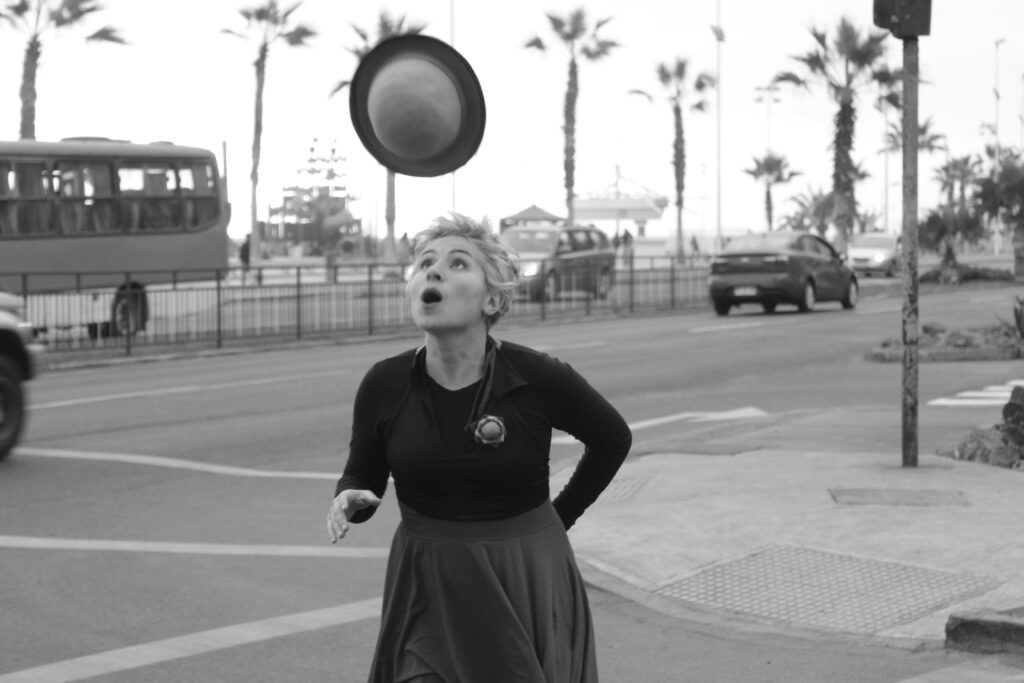
MM: While we were organizing the documentary and reflecting on the ideas we wanted to convey through it, you said that “this is a snapshot of the current state of juggling in Chile in 2023.” Do you think it is an accurate picture? And, do you think that if we were to revisit this “photograph” in ten years, Chilean juggling would have changed? In what way?
MT: I believe that no photograph is faithful to reality. Behind every image, there is always an intention and a partial vision. In this case, the intention is to account for a plurality of approaches that have been consolidating for years. If in the city of Santiago de Chile, juggling started in the 1990s as a youth movement seeking a means of expression or as a pretext to gather and share in public spaces, attempting to overcome the traumatic 17 years of military dictatorship (1973-1990) that eliminated social life from public spaces, today that objective is still present, as juggling continues to attract many young people to come together around the discipline. However, the goals have diversified and expanded far beyond that initial impulse.
Therefore, I believe that inevitably, in ten more years, the landscape will be different. And I venture to say that this plurality will surely continue to expand, with new approaches related to new virtual media, innovations in toy-making materials, and the need to stimulate body use through meditative activity and, ultimately, to continue promoting social interaction in a playful way.
I imagine that in ten more years, the field of Chilean juggling will be a much more complex space, both in concrete and abstract terms. It will be more professionalized, more balanced in its dimensions, and more recognized at an institutional level (as art, as a sport, as therapy, as a means of integration and social interaction, as a market, etc.).
MM: What was the process like? What were the difficulties, and the discoveries?
MT: I think this process took place the way that any project takes place. By that I mean that when a need arises to do something concrete related to a topic of interest, there is always a stage in which ideas are projected without limits and one imagines many things, makes many expectations. And after that process, it is time to make the descent, to land the ideas and limit the expectations according to one’s own specific times and resources.
In that sense, I think the project developed quite nicely. Although we did not reach the goal within the stipulated time and were not able to portray all the dimensions that we had proposed, in that extra time, we were able to make the general idea come together in a better way. It also allowed us to interview people in person who did not live in Santiago. So, what could be considered a difficulty or limitation indirectly allowed us to enrich the process and the viewpoint.
And in relation to the findings, I would say that it is possible to conclude that Chile has a complex juggling field that has developed independently of cultural institutions. One of the virtues of juggling is that it does not require a large infrastructure for training, unlike most circus techniques, which do. So, along these lines, what for the circus, in general, is a disadvantage for juggling has been an opportunity. Because for almost 30 years, the main and most effective development strategy has been to congregate, train and share knowledge in the public space, which has fostered a sense of belonging and a collective identity.
Consequently, this has also allowed juggling to gain massive visibility because, when installed in the public space as, say, a traffic light micro-show or a street presentation, it becomes part of the daily landscape of our country’s cities.
Do you have a story to share? Submit your news story, article or press release.

